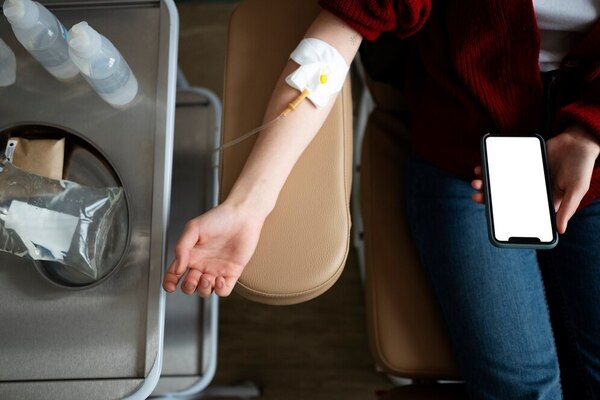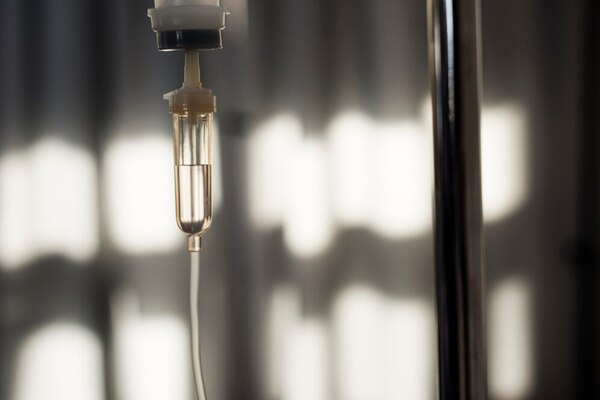Regenerative medicine has taken a transformative leap in recent years, and within this field, stem cell therapies have emerged as one of the most promising options for treating a wide range of chronic and degenerative conditions.
At Cellular Regeneration Clinic (CRC), located in Tijuana, Mexico, we specialize in stem cell treatments, providing a safe, effective, and non-invasive alternative for individuals seeking to improve their health and quality of life without the need for surgery.
One of the most accessible and versatile applications is the intravenous (IV) infusion of stem cells. This procedure allows stem cells to circulate throughout the body via the bloodstream, naturally homing in on the areas where they are most needed. In today’s CRC blog, we’ll cover everything you need to know about this therapy.
What Is Intravenous (IV) Stem Cell Therapy?
IV stem cell therapy involves the infusion of stem cells, often combined with exosomes, directly into the bloodstream via an intravenous line.
Once administered, stem cells travel throughout the body, responding to cellular stress signals emitted by damaged or inflamed tissues. They play a critical role in tissue repair, immune modulation, and systemic inflammation reduction—essentially acting as a biological rescue system.

Types of Stem Cell Therapies
There are multiple types of stem cell therapies, each with unique characteristics and clinical applications. Below are the primary approaches based on method of administration:
Stem cell IV infusion
This is the most common and least invasive method. Stem cells are infused directly into the bloodstream, reaching multiple organs and tissues. It is ideal for:
- Anti-aging and longevity optimization
- Autoimmune and inflammatory conditions
- Systemic tissue regeneration and recovery
Intraarticular Injections
This localized approach targets specific joints affected by arthritis, injuries, or degenerative conditions (e.g., knee, shoulder, hip, elbow). The goal is to reduce pain, decrease inflammation, and repair damaged tissues. Since blood flow is limited in joints, the cells remain localized and do not exert systemic effects.
Intrathecal Administration
Stem cells are delivered into the cerebrospinal fluid (CSF) via lumbar puncture, allowing direct access to the spinal cord and brain. This method is reserved for neurodegenerative conditions such as:
- Parkinson’s Disease
- Alzheimer’s Disease
- Multiple Sclerosis
- Post-stroke brain injury
Pulmonary Nebulization
Indicated for respiratory conditions like COPD or long COVID. Stem cells and exosomes are aerosolized and inhaled through a nebulizer mask, targeting the alveoli and bronchi directly.

Aesthetic and Anti-Aging Therapies
Localized application of stem cells and exosomes to the face, scalp, or neck stimulates collagen and elastin production, enhances skin texture and tone, promotes hair growth, and reduces inflammation. This approach offers:
- Skin rejuvenation
- Accelerated healing
- Youthful tissue regeneration
Autologous vs. Allogeneic Transplantation
Stem cell therapies can also be classified based on their source and donor type:
- Autologous: Stem cells are harvested from the patient’s own fat or bone marrow and reinfused. Commonly used in oncology (e.g., leukemia, multiple myeloma).
- Allogeneic: Stem cells are sourced from a donor who may be a relative with a similar genetic makeup to the patient. However, cells from unrelated individuals are also utilized due to clinical advantages such as high concentration and enhanced efficacy in degenerative diseases.
Note: CRC does not use embryonic stem cells under any circumstances.
Stem Cell-Assisted Reconstructive Surgery
In select cases, stem cells are combined with surgical reconstruction to accelerate healing and improve outcomes. Indications include:
- Post-traumatic reconstruction
- Complex musculoskeletal injuries
- Advanced plastic and cosmetic surgeries
- Chronic ulcers and necrotic tissue regeneration
Stem cells support new tissue growth, increase vascularization, and enhance recovery timelines.
Benefits of IV Stem Cell Infusion
IV stem cell infusion is a powerful tool in modern regenerative medicine. Thanks to their regenerative, immunomodulatory, and anti-inflammatory capabilities, stem cells provide a broad spectrum of benefits for both patients with existing health conditions and individuals seeking to optimize their health and longevity.

Systemic Inflammation Reduction
Low-grade chronic inflammation is a root cause of many modern diseases, including diabetes, arthritis, cardiovascular disease, and autoimmune conditions. Stem cells naturally reduce inflammation by:
- Downregulating pro-inflammatory cytokines
- Rebalancing overactive immune responses
- Relieving chronic pain linked to persistent inflammation
- Creating a favorable environment for cellular healing and homeostasis
Tissue Repair and Regeneration
Stem cells can differentiate into various cell types—cardiac, hepatic, renal, pulmonary, cartilage, and more—allowing them to:
-
- Repair organs affected by chronic disease
- Revitalize aged or damaged tissues
- Stimulate angiogenesis (new blood vessel formation)
Immune System Modulation
Stem cells help regulate a dysfunctional or overactive immune system, making them ideal for:
- Patients with autoimmune diseases (e.g., lupus, rheumatoid arthritis, Hashimoto’s)
- Individuals with allergies or chronic fatigue
- Mitigating abnormal inflammatory responses
- Restoring immune tolerance and equilibrium
Increased Energy and Vitality
One of the most frequently reported benefits is a significant boost in energy, mental clarity, and emotional well-being—attributed to:
- Reduced cellular oxidative stress
- Mitochondrial rejuvenation
- Lower levels of systemic inflammation
- Hormonal optimization at a systemic level
Many patients describe feeling younger, sharper, and more physically capable after treatment.

Biological Age Reversal
Repeated clinical observations show that regular stem cell infusions can slow or reverse biological aging, through:
- Enhanced cellular turnover and regeneration
- Replacement of senescent or damaged cells
- Improved function of key organs such as the liver, kidneys, and heart
- Noticeable changes in skin tone, muscle firmness, cognitive sharpness, and hair growth
Degenerative Disease Prevention
IV stem cell therapy also serves a preventive function for healthy individuals over 40—when natural stem cell production begins to decline. Periodic infusions may:
- Replenish regenerative cell reserves
- Strengthen organ systems before deterioration sets in
- Buffer the effects of stress, toxins, and unhealthy lifestyle factors
Faster Recovery After Illness or Surgery
After physical trauma or surgery, the body’s natural healing capacity may be compromised. IV stem cell therapy accelerates recovery by:
- Promoting tissue healing
- Clearing cellular debris
- Stimulating blood vessel and structural regeneration
Patients often experience shorter recovery periods and reduced complications.
How Does an IV Stem Cell Infusion Work?
The process is simple and comfortable. After a brief medical evaluation, the patient is seated in an infusion room, and a saline solution enriched with 60 to 150 million stem cells and up to 5 billion exosomes is administered over a 20 to 40-minute period.
The infused cells travel throughout the bloodstream, homing in on areas of inflammation or dysfunction by following biochemical “SOS” signals. Once localized, they initiate the repair, regeneration, and immune regulation processes.

Conditions Treated with IV Stem Cell Therapy
Currently, IV stem cell therapy is used in patients with:
- Type II Diabetes
- Lupus and autoimmune disorders
- Chronic fatigue and fibromyalgia
- Post-cancer fatigue or inflammation
- Long COVID
- Kidney or liver insufficiency
- COPD and lung fibrosis
- Mild heart failure
- Cognitive decline or brain fog
- Hormonal imbalances
- Preventive anti-aging and longevity care
Risks and Side Effects
Although generally safe and well-tolerated, IV stem cell therapy, like any medical procedure, carries minimal risks, such as:
- Mild warmth or discomfort during infusion
- Temporary fatigue or mild headache
- Minor immune reaction in rare cases
Due to the low immunogenicity of stem cells, rejection is extremely rare. At CRC, all products are certified, and procedures are conducted under rigorous medical supervision.
Frequently Asked Questions
Below, we answer some of the most common questions our patients ask us during consultations:
Who is a Candidate for IV Stem Cell Therapy?
All patients undergo a medical evaluation to determine eligibility. Ideal candidates include individuals with chronic, degenerative, or autoimmune conditions. However, healthy individuals over the age of 38 may also benefit as a preventive or anti-aging measure.

Is IV Stem Cell Therapy Safe?
Yes. At CRC, we use only laboratory-processed, certified donor stem cells from our in-house stem cell bank. Treatments follow validated medical protocols with full regulatory compliance in Mexico.
How Much Does IV Stem Cell Therapy Cost?
Pricing varies depending on dosage and treatment goals. On average, a standard infusion ranges between $4,500 and $7,500 USD, including consultation, U.S. border transportation, and cell viability certification. Discounts may apply for multi-treatment or maintenance packages.
Are you a candidate for IV stem cell therapy?
At CRC, we’re ready to evaluate your case and design a customized wellness plan. Contact us today to schedule your consultation—our team will gladly assist you.


